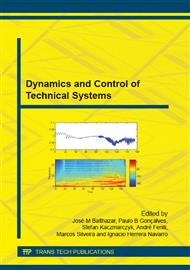[1]
ISO 2003, Lifts Measurement of lift ride quality, ISO 18738: 2003(E) (2003).
Google Scholar
[2]
I. Herrera and S. Kaczmarczyk, The Assessment of Vibration Absorption Capacity of Elevator's Passengers, 7th International conference on Modern Practice in stress and Vibration Analysis, Journal of Physics: Conference Series 181(2009).
DOI: 10.1088/1742-6596/181/1/012081
Google Scholar
[3]
I. Herrera, H. Su and S. Kaczmarczyk, Investigation into the damping and stiffness characteristics of an elevator car system, Applied Mechanics and Materials, Trans Tech Publications. 24-25 (2010) 77-82.
DOI: 10.4028/www.scientific.net/amm.24-25.77
Google Scholar
[4]
M.J. Griffin: Handbook of Human Vibration, Academic Press Limited, London, (1990).
Google Scholar
[5]
J. Rosen and M. Arcan, Modeling the Human Body/Seat System in a Vibration Environment, Journal of Biomechanical Engineering. 125 (2003) 223-231.
DOI: 10.1115/1.1559894
Google Scholar
[6]
X. Linan, Z. E, L. Mingli, S. Xiaochun and Z. Fan, Human Vibration Characteristic and Experiment Research on Man-Machine System in Dynamic Environment, 9th Inernational Conference on Computer-Aided Industrial Design and Conceptual Design. (2008).
DOI: 10.1109/caidcd.2008.4730545
Google Scholar
[7]
Ya Huang, Mechanism of nonlinear biodynamic response of the human body exposed to whole-body vibration, Thesis, Faculty of Engineering, Science and Mathematics, Institute of Sound and Vibration, University of Southampton.
Google Scholar
[8]
G.H.M.J. Subashi, Y. Matsumoto and M.J. Griffin, Apparent mass and cross-axis apparent mass of standing subjects during exposure to vertical whole-body vibration, Journal of Sound and Vibration. 293 (2006) 78-95.
DOI: 10.1016/j.jsv.2005.09.007
Google Scholar
[9]
G.H.M.J. Subashi, Y. Matsumoto and M.J. Griffin, Modelling resonances of the standing body exposed to vertical whole-body vibration: Effects of posture, Journal of Sound and Vibration. 317 (2008) 400-418.
DOI: 10.1016/j.jsv.2008.03.019
Google Scholar
[10]
A.A. Nikoyan, A.A. Zadpoor, Mass-spring-damper modelling of the human body during running and hopping - an overview, Proceedings of the Institution of Mechanical Engineers, Part H: Journal of Engineering in Medicine. Review (2011) 1121-1135.
DOI: 10.1177/0954411911424210
Google Scholar
[11]
X. Zheng and J.M.W. Brownjohn, Modeling and simulation of human-floor system under vertical vibration, Smart Structures and Materials 2001. Proceedings of SPIE 4327 (2001).
DOI: 10.1117/12.436586
Google Scholar
[12]
T.C. Gupta, Identification and Experimental Validation of Damping Ratios of Different Human Body Segments Through Anthropometric Vibratory Model in Standing Posture, Transactions of the ASME, 129 (2007) 566-574.
DOI: 10.1115/1.2720917
Google Scholar
[13]
F.M.L. Amirouche, M. Xie, A. Patwardhan, Optimization of the Contact Damping and Stiffness Coefficients to Minimize Human Body Vibration, Journal of Biomechanical Engineering. 116 (1994) 413-420.
DOI: 10.1115/1.2895792
Google Scholar
[14]
N. Even-Tzur, E. Weisz, Y. Hirsch-Falk and A. Gefen, Role of EVA viscoelastic properties in the protective performance of a sport shoe: Computational studies, Bio-Medical Materials and Engineering 16 (2006) 289-299.
Google Scholar
[15]
Q.H. Ly, A. Alaoui, S. Erlicher, and L. Baly, Towards a footwear design tool: Influence of shoe midsole properties and ground stiffness on the impact force during running. Journal of Biomechanics. 43 (2010) 310-317.
DOI: 10.1016/j.jbiomech.2009.08.029
Google Scholar
[16]
J.F. Wilson and R. D. Rochelle, Football dynamics for racewalkers and runners barefoot on compliant surfaces. Journal of Biomechanics. 42 (2009) 2472-2478.
DOI: 10.1016/j.jbiomech.2009.07.020
Google Scholar
[17]
W. Qassem, Impulse response due to jumping on shoes of various stiffness and damping, Bio Medical Materials and Engineering 13 (2003) 167-180.
Google Scholar
[18]
B. Balachandran, Vibraciones, Thomson, (2006).
Google Scholar
[19]
Da Silva, Vibration, Damping, Control, and Design, CRC Press, (2007).
Google Scholar
[20]
H.P. Den Hartog, Mechanical Vibrations, Mc Graw-Hill, (1956).
Google Scholar
[21]
J.L. Yus, Weight distribution of elevator car components for different sizes, MP Ascensores, Zaragoza, Spain, Internal Report. (2013).
Google Scholar


